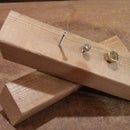Introduction: Hard Shell Stackable Storage/Travel Cases
Background
The hardware store near my house sells a ton of tools, many of which seem to be sold without their cases. Because of this, they usually have a big stack of free tool cases outside for the taking. They are rugged and stackable and can even be locked if needed, which makes them perfect for storing equipment or parts.
I've looked at many cases before from different brands and DeWalt cases seem to be the best fit for this project. Inside they have thin "walls" to hold the tools in place, which are easy to cut. Other brands seem to be moulded to the shape of the tools. Probably better support for the tooling, but harder to remove.
If possible, I would recommend getting multiple boxes of the same tool. This will make sure that they stack perfectly.
Tools
- Dremel
- Cutting discs
- Box Cutter
- Pliers
Ingredients
- DeWalt hard tool cases
- Foam Sheets
Step 1: Prepare the Boxes
This is the most time-consuming part of this project. You have to cut out the little "fences" in the boxes to open them up. If you have a specific use for these or you have a tool/part that would fit nicely inside them, leave them there.
Safety
Always use safety glasses and ear mufflers when using tools like a Dremel. A lot of plastic flies off when cutting these boxes. Even small pieces can cause a lot of troubles with your eyes, and you only have one pair!
Also, when changing discs on the Dremel, make sure to have the tool unplugged from the wall.
When you cut off a fence, there is a good chance that the plastic melted and is really hot. Make sure to take your time, let the plastic cool a little for pulling the pieces out. The freshly cut edges can also be pretty sharp too. Be careful when removing cut-offs
Cutting
With a cutting disc attached, start cutting down all the fences. You don't need to do each fence in one shot, you can remove it in multiple pieces. Yes, this seems inefficient, but is actually much faster. You don't need to fight to get the tool to fit, you can cut open the area, then it fits easily.
Also, when cutting, you don't need to get all the way to the outside of the case in the first cut. It is often easier to cut down the fence and leave a 1/2" gap between your cut and the shell of the case. Once it is removed, you can come back and make a cleaner cut right up to the shell. Makes the final cuts nicer and much less tedious to do.
Since you are just cutting plastic, these blades will last for a really long time.
If you have a piece in a corner that you are having trouble reaching with the Dremel, remember that you are working with plastic, which has a lot of options for working with it. Pull out a pair of pliers and just twist and pull out the last of the piece. It's not as fun as cutting away with your power tools, but there may be cases where it works better.
As you're cutting, if you get a little too aggressive and the shaft hits the plastic, you can get a ring of plastic stuck to the shaft. This isn't a huge problem, but can start to get in the way. If this happens, just take some pliers and break it off.
Other Options
If you don't have a Dremel, I would assume that tin-snips or a stiff knife would work well enough for removing these fences, but I didn't try these. Also, a knife can be dangerous if you aren't careful, so take your time!
Step 2: Pad the Boxes
How you pad the boxes has a lot to do with what you are putting in them. If you have more fragile equipment, individual packing holes are wonderful to keep them from bouncing around when in transit. A general layer of foam would be beneficial for almost anything in these boxes. Unless you were way more meticulous that me in removing your fences, there will still be some rough/sharp edges.
Foams
Solid Foam - http://canada.foambymail.com/CR_2/charcoal-foam-ba...
Eggcrate Foam - http://canada.foambymail.com/ECCR/eggcrate-charcoa...
Pick and Pluck Foam - http://canada.foambymail.com/PNPCR/pick-and-pluck-...
Main Padding
You will first want to put down a base-layer of padding. For that, I used some eggcrate foam, but the solid foam would work just as well.
Measure the size of your box and using a box-cutter, cut the foam down to size. Make it about 1/2" larger than your box. This should be enough to have the foam hold itself in place on its own once squished into place. Once it is cut, squish it into place. If your pieces aren't quite big enough, you can use cut-offs to fill in the gaps. If the foam isn't staying, some spray adhesive will probably help hold your base-layer in place.
Inside the box, there may be some insets for the handle or the latches. Try to cut around these to make your foam evenly compressed
Step 3: Lay Out Your Bits
This final layer of padding is to layout your individual components and make little cubbies for each one. For this, we use the Pick and Pluck foam. This is exactly what it is meant for and it is wonderful! If you are trying to cut costs, you can use some solid foam and cut holes with a knife.
Lay down your foam in top of your base layer, then lay out all of your components on top of it. This will help you get your box organized the way you want it. This is a point in your life where those Tetris skills are finally coming in handy! Once you have your pieces laid out, you can mark where they go with a knife or a marker on the foam.
Step 4: Make Some Holes
Remove all of your components and start pulling out the squares in the foam under where they were. There will be little connections between the foam squares on the sides of them. Rip them with your hands or cut through them with a knife. If you aren't exactly sure where the component, put it back on top to make sure it's in the right place. You can always fill in holes with scrap foam squares, but it's nicer and your components will stay in-place better if the foam is connected all the way around
Step 5: Put Everything Away
Now that you have the cubbies made, send your components home! Put them all back in where they go and close up the box! You should feel a little force when closing the box lid. That means that the foam is compressing around your components and holding them snuggly. If this isn't the case, when you pick up your box, your components could rattle around and bump into each other or the case sides. Add another layer of foam under your components or in the lid so it closes tight. Also, if you have components that are different heights, you can add a layer of foam just over the smaller pieces to hold them differently from the larger components.
Take all of your boxes and stack them somewhere nice. The containers will "lock" together so they can be bumped around and won't fall over. Shelf, floor, hung from the ceiling, there are valid storage location for these boxes.
Step 6: Final Thoughts
These cases are awesome. Sturdy, flexible, and best of all, free! I've had a lot of different things floating around in boxes, bags, piles, etc. so it's nice to actually have proper storage for them.
Other Options
Storing strangely sized objects - I have a ton of small power supplies. Different voltages, currents, plugs. Since they are all weird sizes, and not individually large enough for their own storage, one of these cases is perfect
Day Box - If you are heading out to do work somewhere else, you can pack yourself a little "day box" that has just the tools you need. It's a tough box with padding, so it can take a little abuse, and with the foam, you can add just the tools you'll need for that job, and even your sandwich won't get squished!

Participated in the
Workshop Hacks Challenge 2017

Participated in the
Reclaimed Contest 2017











